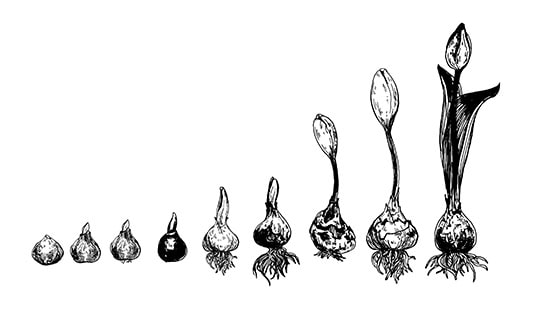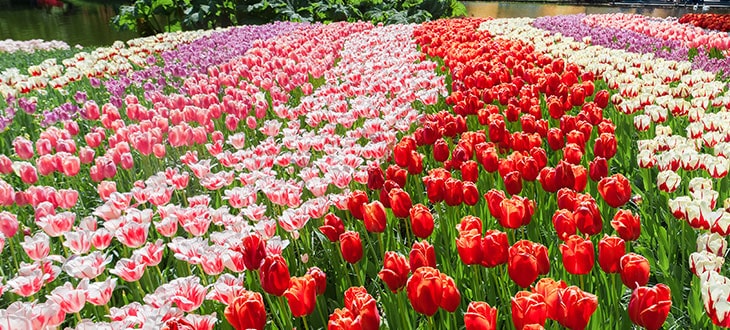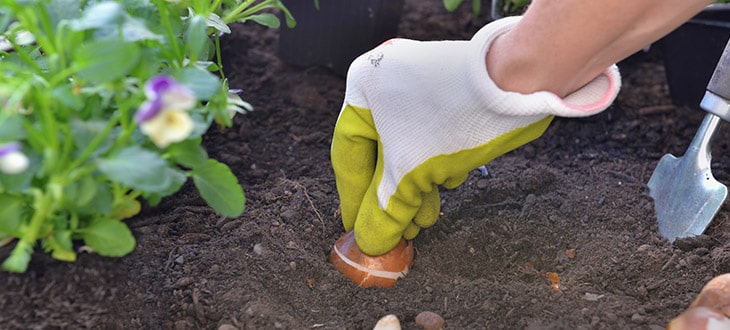How To Plant Tulip Bulbs
How to plant tulip bulbs? Find out which is the best time of the year to plant tulips, the optimal temperatures, soil requirements, and more from our tulip bulbs planting guide.
Disclosure: This page contains affiliate links. This means that the owner of this website might be compensated for any qualifying purchases made via these links.
Tulips are some of the most popular flowers in the world due to their beauty and the color diversity that bring freshness and liveliness to any garden. Although they are typically associated with the Netherlands, tulips originate from the Persian Empire.
Tulips can be propagated by both seeds and bulbs. However, the most commonly used method of propagating these flowers is through bulbs because when they are grown by seeds, they need between 4 to 7 years to produce flowers.
Bulbs are underground modified stems. They have a role in storing food during the winter dormancy period, bring the plant back to life in the next vegetative season, as well as to help the plant multiply.
Further, we will talk about how to grow tulips from bulbs, which is the best time of year for planting, and the best conditions for growing these plants.
Contents
How To Plant Tulip Bulbs
In order to give our tulips the best chances to produce their amazing flowers in the next season, it is essential to plant the bulbs in the most favorable conditions.
Bulb Selection Before Planting
When using the bulbs that you dug up in the previous year, before planting, it is recommended to make a bulb selection. This process involves removing damaged or dry bulbs, as well as those with scratches, cuts, or soft areas.
The next step is to sort the bulbs by size. Only the larger bulbs will produce plants that bloom in the coming spring. Pick the ones that have about 1 inch (2.5 cm) or more in diameter for the flower production. Plant the smaller ones separately as they need to grow before being able to deliver plants that flower. These will typically only produce flowers after 2 years.
Bulb Planting Position
If you have planted flower bulbs before, you already know the correct position in which you should plant the tulip bulb.
Tulip bulbs have a pointy side and a more rounded one. The pointed part should always be placed upwards, being the side where the plant will grow. The roots of the plant will develop on the rounded side.

Once you have the holes ready, place the bulbs gently inside, without pressing. This could damage their base and prevent the plant setting.
When To Plant Tulip Bulbs?
The best time to plant tulip bulbs is in the fall, typically between October and the start of December. However, in some climates, if the soil is not frozen and the temperatures are not yet extremely low, planting can be done even in December.
Tulip bulbs require a cold period of 3 to 4 months. During this time, they will stay dormant and begin to grow once the soil starts to become warmer during the spring.
Planting the tulip bulbs in August or early September, is risky as it may be followed by a sudden temperature change. An early frost followed by a warm period will cause the bulb to go prematurely into vegetation, and the establishment of actual winter will freeze the leaves, hence, killing the bulb.
If you didn’t get the chance to plant the tulip bulbs in the fall, you can also plant them in early spring. Yet, first, make sure that the soil is not already too hot for them. Establishing the bulbs too early or too late, in soils that are humid and warm will cause the bulbs to rot.
Some avoid planting tulips in the fall due to the fear that the bulbs may freeze during a very cold winter. However, the bulbs are cold-resistant and can withstand severe freezing temperatures when buried deep in the ground.
You can artificially give tulip bulbs a cold period by keeping them in a cool place during the winter or in a refrigerator, at a temperature of about 40° F (4° C).
While bulbs can withstand temperatures well below freezing when buried, they will freeze if exposed to extreme conditions when unburied. Hence, do not put them in freezers as the temperature is way lower than in refrigerators, approximately 0° F (-18° C).
Although tulips are plants that grow very well outside, they can also be planted in pots. Just as when you are planting them outside, the best time to plant the tulip bulbs in containers is in the fall.
How Deep To Plant Tulip Bulbs?
The best depth for planting a tulip bulb is between 6 to 8 inches (15-20 cm). There is also a universal rule that says that a bulb should be planted at a depth that is at least twice its height.
If you have many bulbs to plant, a bulb planter may come in very handy for digging out the holes.
A three-year study conducted by Dr. William B. Miller for the Flower Bulb Research Program (FBRP) of Cornell University pointed out that tulip bulbs can also grow on the ground surface when a layer of 2 to 4 inches of mulch is used to cover them.
Even though this technique enables you to plant the bulbs faster when you plant entire fields, planting the bulbs too close to the surface of the soil will make it easier for squirrels, rabbits, mice, chipmunks, and other animals to dig them up and they may also become more susceptible to frost.
Tulip bulbs are a delicacy for squirrels and other small rodents. So if you live in an area where you constantly have problems with pests, it is recommended to apply a repellent that masks the smell of the bulbs after planting.
Choose deep, roomy pots when planting tulips in containers. In pots, tulips can be planted at slightly lower depths than in the garden.
Should Tulip Bulbs Be Planted In The Sun?
Tulips thrive in places that receive sunlight throughout the day. Hence, when planting them outside, you must first choose a place where they will receive plenty of sunshine.
In climates with very high temperatures during the summer, tulips also grow quite well in semi-shade, or when they receive only the morning sun. Although tulips are plants that enjoy being in the sun, extreme heat can also be detrimental to them.
Therefore, it is best to choose the spot where you plant the tulip bulbs based on the climate of the area where you live.
What Is The Best Soil For Planting Tulips?
Tulips are not very demanding when it comes to soil conditions. However, better results are obtained in clay-sandy soil, which is rich in humus and allows good water drainage. If your garden soil is very bad, you can add a bit of compost.
If you choose to plant the tulip bulbs in a pot, make sure that it has enough drainage holes at the bottom. You can even add a layer of stones on the bottom of the pot to prevent the dirt from filling up the drainage holes and to ensure that the excess water does not remain in the container.
Tulip bulbs do not need fertilization at planting.
Initially, bulbs use the food reserves accumulated in the previous season to develop the plant. Thus, they do not require too many external nutrients from the soil.
The best time to provide fertilizer to tulips is during spring and after the flowering period.
Final Word

Tulips are some of the most beautiful spring flowers. They are available in a wide variety of colors and give life to any place.
Now that you know how to plant tulip bulbs, nothing should stop you from growing these beautiful flowers in your garden or in pots.
Tulips are truly charming flowers and because they don’t have any special requirements, anyone can grow them.



